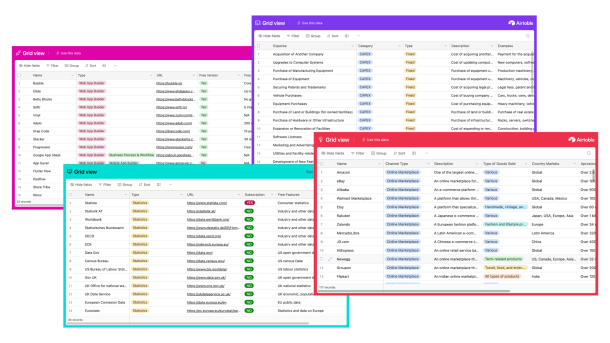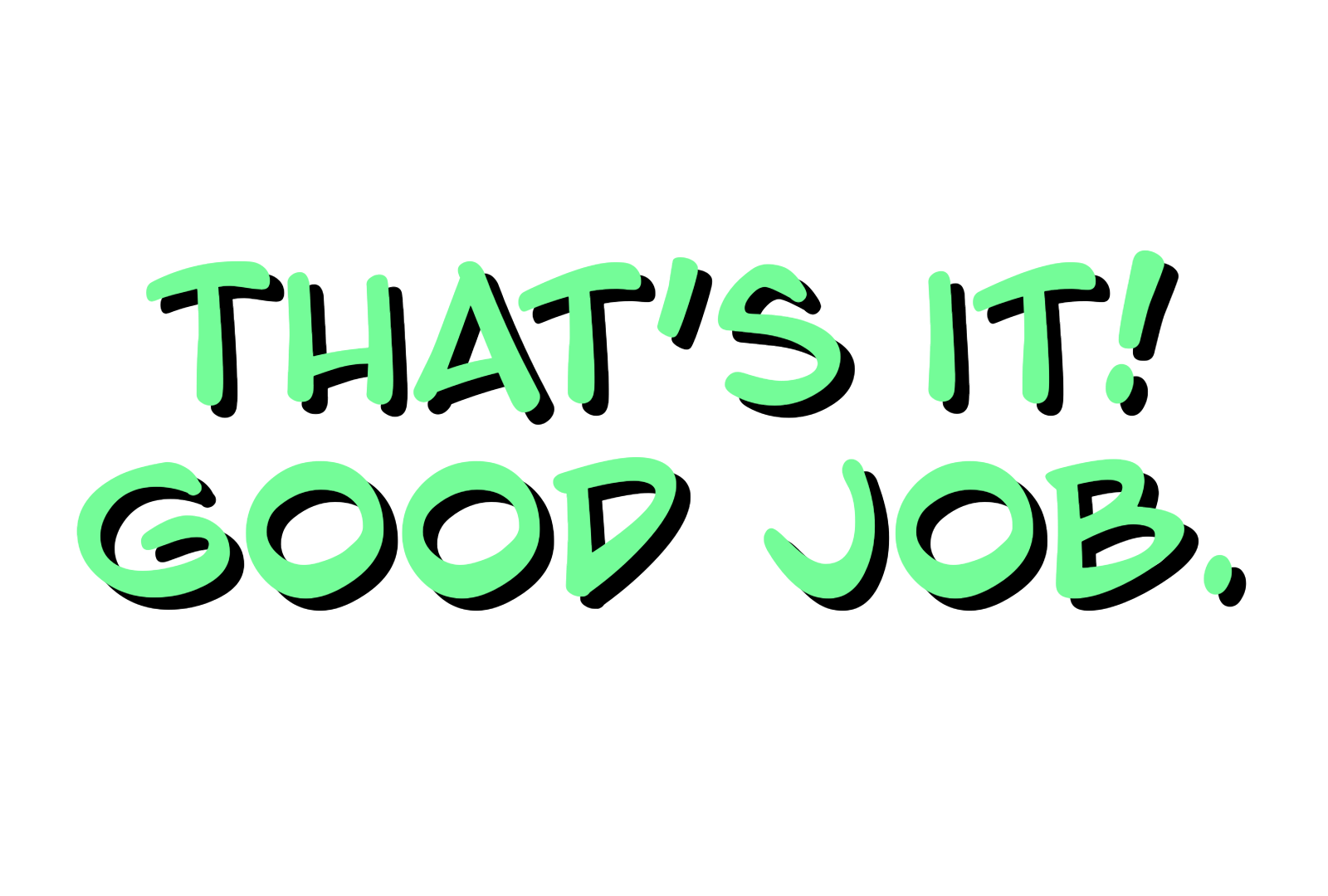Agile Project Management Guide
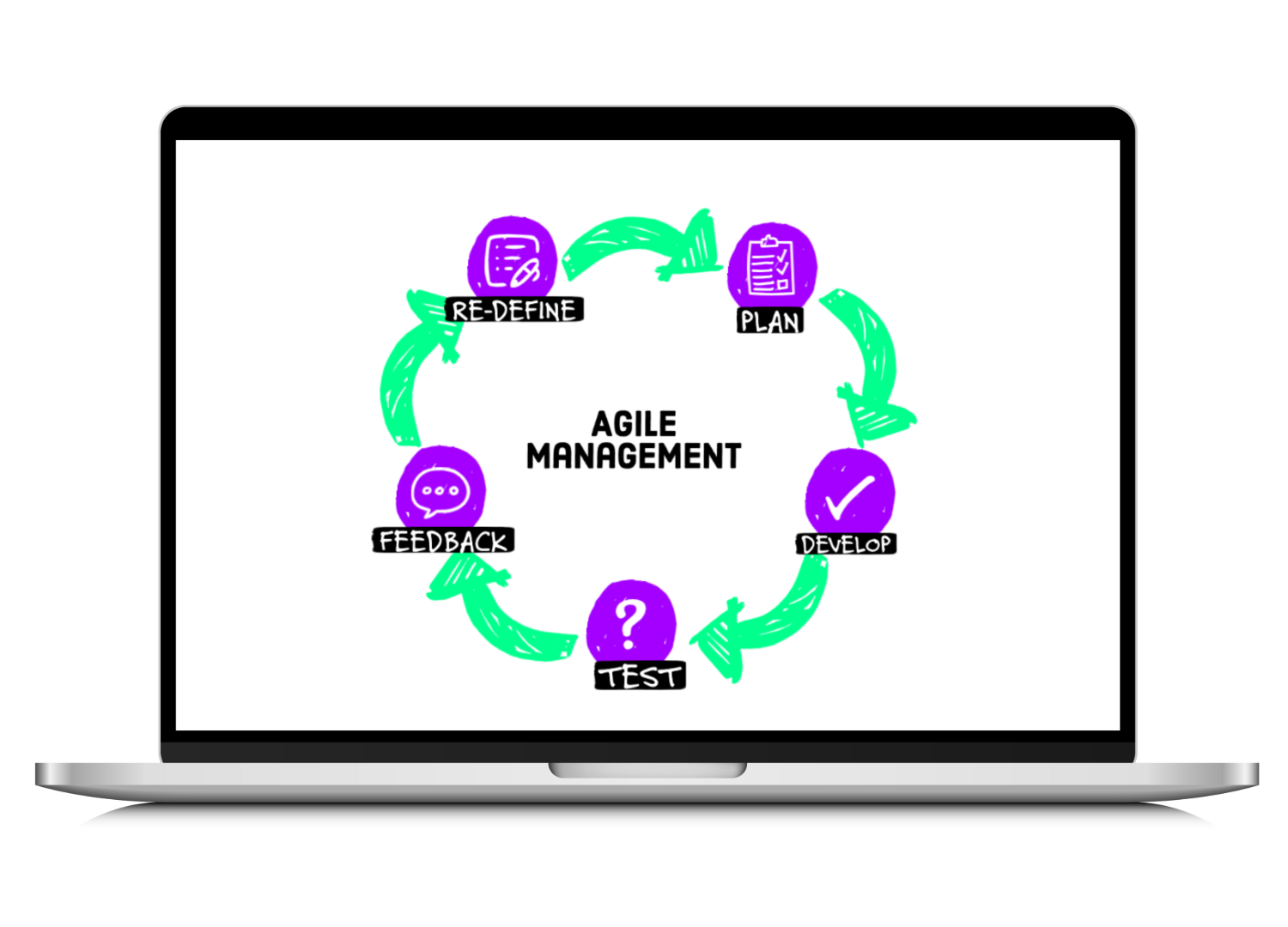
What is Agile Project Management?
There are a variety of great agile project management methods that are especially helpful when it comes to product development. Well known methods include for example SCRUM or KANBAN with whole books written about them and even dedicated certificates you can get for mastering those methods.
In this guide we will look at different tools while still keeping it simple and adapt them to make them applicable, not only to tech products, but to the development of other business models as well.
So what is special about agile management? Agile management is an approach to project management and software development that emphasizes flexibility, adaptability, collaboration, and responsiveness to change. It was originally developed for software development projects, but it has since been adapted for use in other industries.
While agile management is a broad umbrella term for this type of project management approach, SCRUM and KANBAN are two specific frameworks for implementing agile management.
SCRUM is a framework that is particularly well-suited for complex software or product development projects. SCRUM involves breaking a project down into small, manageable tasks called “user stories” and working on these tasks in short cycles known as “sprints.” The SCRUM framework includes specific roles, such as product owner, scrum master, and development team, as well as ceremonies like sprint planning, daily stand-up meetings, and sprint reviews.
KANBAN is another framework for implementing agile management that is often used in manufacturing and other non-software development contexts. KANBAN involves visualizing the workflow of a project using a Kanban board, which typically includes columns for “To Do,” “In Progress,” and “Done.” The KANBAN framework emphasizes limiting work in progress, focusing on continuous improvement, and using data to make decisions.
Within this guide we will use a mix of both frameworks to establish a simple project management method that can be applied to the development of both, tech and non-tech products.
Note: 🍋 Throughout this guide we will use the example of a food supplement company to better illustrate each task and information.
What is Agile Project Management Good For?
Agile project management is crucial for businesses seeking to stay competitive in today’s fast-paced environment. Its benefits extend beyond efficiency gains to fostering innovation, collaboration, and customer satisfaction. Here are some key advantages of agile project management:
- Adaptability: Agile methodologies enable teams to respond quickly to changes in project requirements or market conditions, ensuring that they remain relevant and competitive.
- Continuous Improvement: By breaking projects into smaller iterations, agile teams can continuously assess their progress, gather feedback, and make adjustments to improve product quality and customer satisfaction.
- Enhanced Collaboration: Agile project management promotes cross-functional collaboration and transparency, fostering a culture of teamwork and shared accountability.
- Faster Time to Market: With its iterative approach, agile enables teams to deliver working products or features more frequently, accelerating time to market and gaining a competitive edge.
Curated Lists 📋
💡 To save you some time, we have prepared a free list of Project & Task Management Tools which you can use when implementing an agile management approach.
How to Implement Agile Project Management Step-by-Step:
Step A: Agile Management Templates
Step B: Agile Project Management Methodology
Step C: Product Development Break Down
Step D: Product Roadmap
Step E: Task Management Board KANBAN
Step F: Agile Management Team Roles
Step G: Agile Management Touchpoints
Step A
Agile Management Templates
To implement agile project management you can either build your own whiteboard templates for example on Miro or you can use our ready-to-use templates along with this guide.
Included Templates:
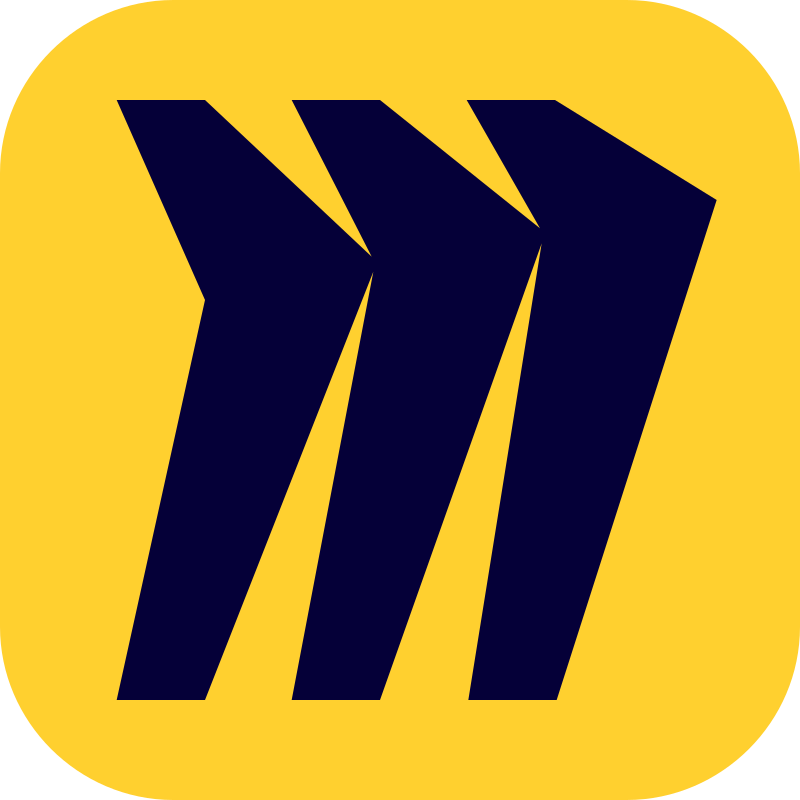
Team Alignment Miro Board

Agile Management Miro Board

Sprint Retrospective Miro Board
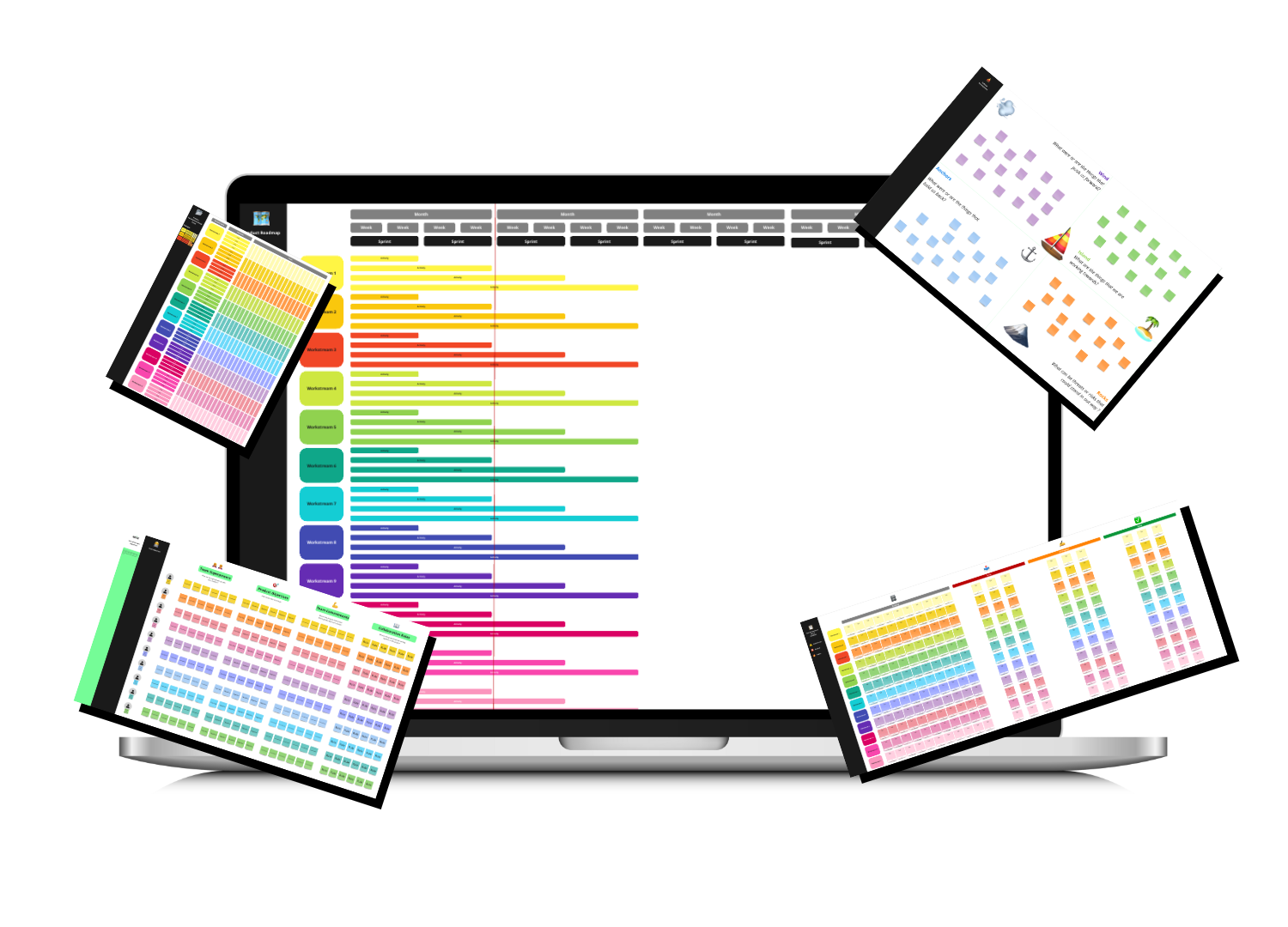
Step B
Agile Project Management Methodology

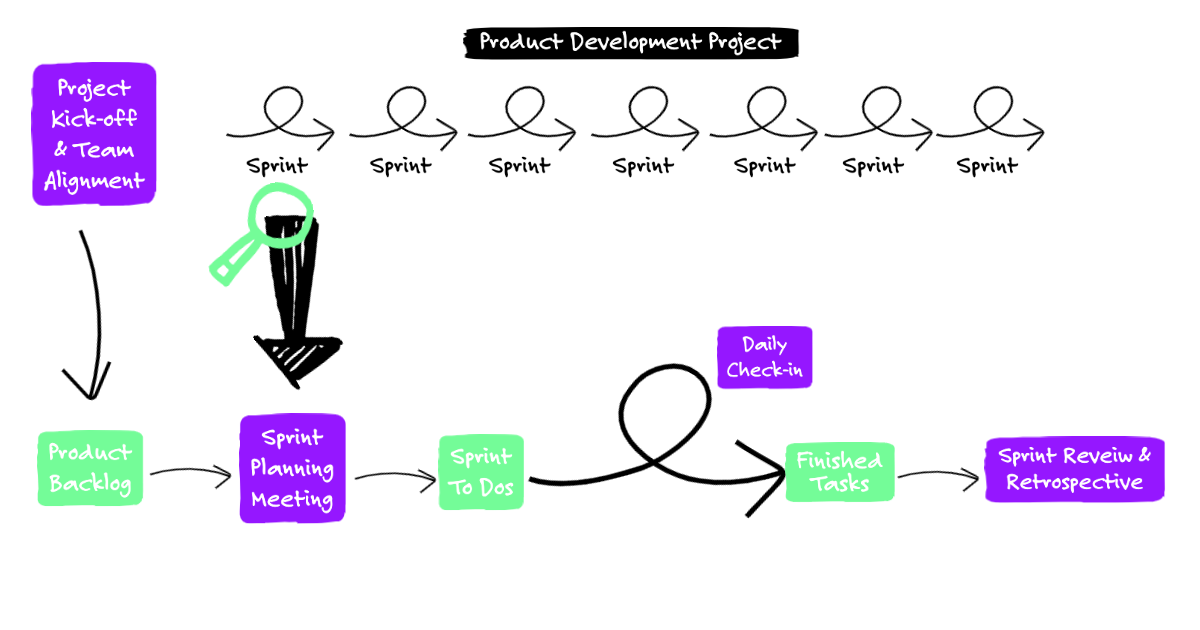
Let’s first talk about your project management methodology, meaning the “how” you manage your product development process in order to assure you work efficiently and stay on time.
We will use an approach inspired by the SCRUM model. The SCRUM model, like other agile management methodologies, is an iterative way to manage projects and develop products that work in sprints. Meaning instead of developing a product end to end and then launching it to the public to get first feedback, this approach breaks down the project into smaller, more manageable pieces that can be worked on by the product development team.
One sprint usually has a duration of one to four weeks, at the end of each sprint, the team reviews their progress, adapts their plans if necessary, and sets new goals for the next sprint. The product is already being tested iteratively during individual sprints. This way the team can quickly adapt to changes and feedback, continuously improve the product, and deliver value to the customer in a timely manner.
Agile management or SCRUM is characterized by a number of key principles, including:
- Customer satisfaction through early and continuous delivery of valuable products/services and features.
- Embracing change, even late in the development process.
- Delivering new working product/service features frequently, with a preference for shorter timescales.
- Collaboration and communication between the development team and stakeholders.
- Trusting and empowering the team to make decisions and self-organize.
Agile management is often contrasted with traditional project management approaches, which are more rigid and emphasize detailed planning and control. While agile management can be challenging to implement in some organizations, it is seen by many as a more effective and efficient way to manage complex projects and deliver high-quality results.
Step C
Product Development Break Down

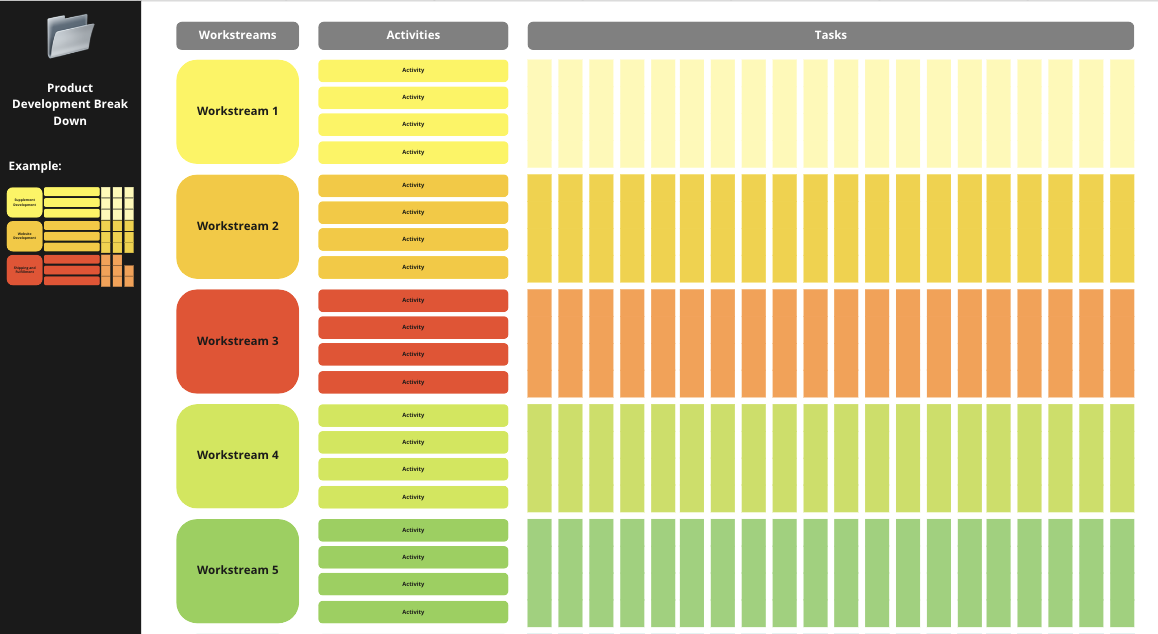
The first thing you want to do is to break down your product development process into smaller packages by identifying the workstreams, activities and tasks. You can use the first part “Product Development Break Down” of your agile project management 📒Template to do so.
Workstream: A workstream is a high-level category or area of focus within the product development process. It represents a set of related activities and tasks that are necessary to achieve a specific goal or objective. Workstreams are then broken down into smaller, more manageable components namely “activities” in order to facilitate planning, execution, and tracking.
🍋in the example of our food supplement venture, three workstream within the product development process could be:
- Workstream 1: Supplement Development
- Workstream 2: Website Development
- Workstream 3: Logistics and Fulfillment
Activity: An activity is a set of related tasks that are performed in order to achieve a specific goal or objective within a workstream. Activities generally comprise several smaller tasks, and may involve multiple team members working together to accomplish a common objective. Activities often represent a major step or milestone in the product development process, and may have dependencies on other activities or tasks.
🍋in the example of our food supplement venture, the activities within work streams 1 could be:
- Work stream 1: Supplement Development
- Activity: Sourcing Raw Materials
- Activity: Supplement Formulation
- Activity: Packaging Design
Task: A task is a specific action or item that needs to be completed in order to achieve a specific goal or objective within an activity. Tasks are smaller in scope than activities, and may be completed by a single team member or small group of team members. Tasks are often more granular and specific than activities, and are typically tracked and managed more closely in order to ensure timely completion.
🍋in the example of our food supplement venture, the tasks to fulfill the activity of sourcing raw materials could be:
- Work stream 1: Supplement Development
- Activity: Sourcing Raw Materials
- Task: Identify suppliers for the raw materials
- Task: Evaluate supplier quality and reliability
- Task: Negotiate pricing and contracts
The coordination and identification of the workstreams, activities and tasks to develop a product or service is usually done by the “product owner” in collaboration with the rest of the team.
Step D
Product Roadmap

Within agile project management there are several tools that help you to manage and keep track of your product development progress. One of those is the product roadmap.
A product development roadmap is a visual representation of a product’s plan for development and release. It is a strategic tool that outlines the major phases, and milestones of your product’s development lifecycle. It outlines the major activities for the different workstreams of the product development process and shows how they are being completed over time.
A product development roadmap is an important tool for product owners and development teams because it provides a clear and organized view of the product development plan. It helps to ensure that everyone involved in the product development process is working towards a common goal and that timelines and milestones are clearly defined and understood.
In addition to communicating the product development plan to internal teams, a product development roadmap can also be used to communicate the product’s development progress to external stakeholders, such as customers, investors, and partners. This can help to build excitement and anticipation for the product’s launch and create a sense of transparency and accountability around the development process.
Your product roadmap should provide a high-level overview of the work packages and a more detailed breakdown of the activities within each work package.
You will find a product roadmap that you can use in your agile project management 📒Template.
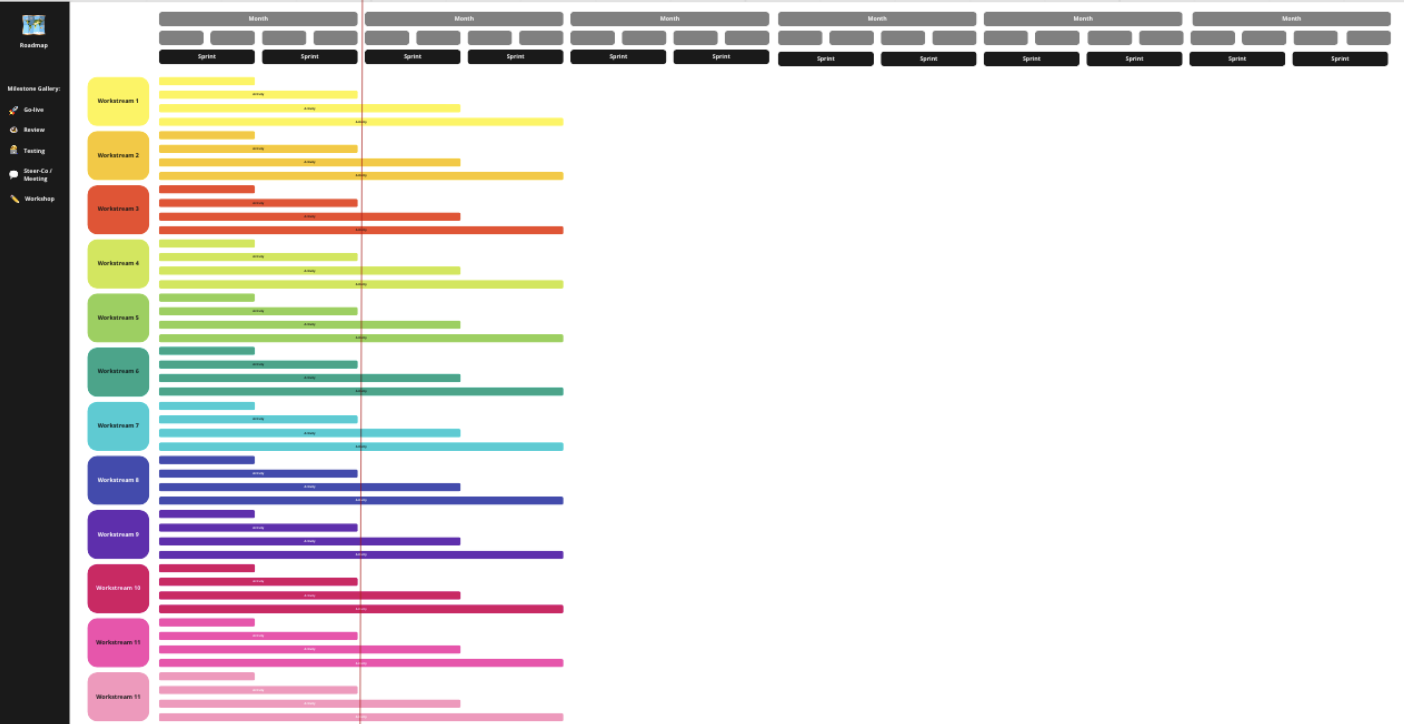
Start by laying out your workstreams and the corresponding activities. Define the roadmap by identifying in collaboration with the team:
- How long it will take to complete the different activities.
- In which sequence you will need to complete the activities and if there are activities that you can complete in parallel.
As mentioned earlier, the agile project management approach works in sprints, a time-boxed period during which a development team works to complete a specific set of tasks. Therefore, you also want to define the length of your sprints and divide your project timeline into the same length sprints (a sprint usually takes between one and four weeks).
Also, you can use the icons from the milestone gallery in your template, to indicate important milestones within the process by copying and placing the icons on the corresponding place on the roadmap:
- 🚀Go-live: use this icon to mark when individual features or product items will go-live
- 👁️Review: use this icon to mark when you will have important team reviews of the work completed so far
- 🧑💻Testing: use this icon to mark at which points you will conduct internal or external user test of the product developed so far
- 💬 Steer-Co/Meeting: use this icon to mark when you will hold important steering committee or other meeting to share results achieved up to this point
- ✏️Workshops: use this icon to indicate when you will hold workshops with the team
With this you get an overview of which activities fall into which sprint, and you can then again move one level deeper and define the tasks which can be worked on in each sprint.
However, keep in mind that this is an iterative process and you will need to stay flexible since tasks might be reprioritized or changed for individual sprints depending on the testing results and feedback.
Step E
Task Management Board KANBAN

To manage the tasks in each sprint you can use a so-called KANBAN board. The KANBAN board is another visual management tool that is used to track and manage work in progress in the product development team on a sprint level. It helps you to ensure that the development process is well-organized, progress can be tracked effectively, and everyone involved in the project is aware of what needs to be done on a more granular level, to achieve the product’s goals in each sprint.
Individual tasks or work items are represented by cards or sticky notes that are placed in the appropriate column on the board. As work progresses, the cards are moved across the board to reflect their current status. This provides a clear and visual representation of the work that is in progress, and helps team members to stay aligned and focused on their priorities.
We also prepare a KANBAN board for you to use within the Agile Project Management 📒Template
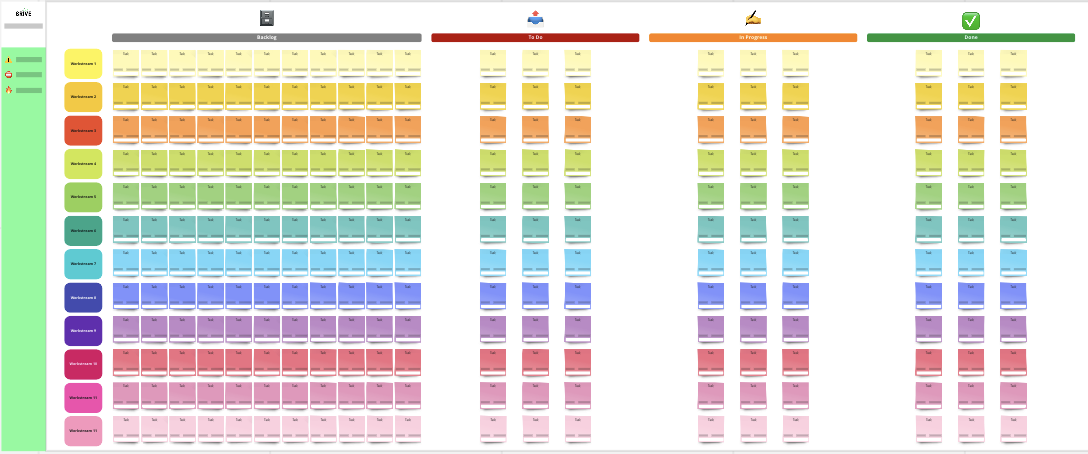
As you will see in your KANBAN template the board consists of four columns:
- Backlog: The backlog column is where all the tasks that you identified are added to the board. This column represents the “to do” list for the team or project, and may include both short-term and long-term goals. Items in the backlog should be prioritized based on their importance and urgency
- To Dos: The to do column represents the work that is planned for the current sprint or iteration. This column typically includes only the highest-priority items from the backlog that are expected to be completed during the current sprint. Items in this column should be clearly defined and well-understood by the team.
- In Progress: The in progress column represents the work that is currently being worked on by team members. Items in this column should be limited to a manageable number, in order to avoid overloading team members and causing bottlenecks in the workflow. Team members should strive to complete items in this column as quickly and efficiently as possible, in order to move them to the “done” column.
- Done: The done column represents the work that has been completed and is ready for review or deployment. Items in this column should be reviewed by the team and/or stakeholders to ensure that they meet the expected quality and functionality requirements. Once approved, items in this column may be marked as “closed” or “completed”, and can be removed from the board or archived for future reference.
Furthermore, you can use the following icons, which you will also find on your template, to highlight issues, blocked or urgent tasks:
- ⚠️Resolve Issue: use this icon to indicate where there is an issue to resolve
- 🛑Blocked: use this icon to indicate tasks that are currently blocked
- 🔥Urgent: use this icon to indicate if a task is especially urgent
By visualizing the tasks in these four columns, a Kanban board provides a clear and transparent view of the work that is in progress and the team’s progress towards completing it. At the beginning of each sprint the team selects the tasks to be completed in the current sprint and moves them from the backlog to the to dos. The board can then be updated in real-time by team members during the ongoing sprint, allowing for a dynamic and responsive workflow that adapts to changing priorities and requirements.
Step F
Agile Management Team Roles

Another important task before starting with your product development is to assign clear roles within the team. Ideally you are working with a team of several people to develop your product, in which every team member can assume a designated role according to their strength and skills.
Within the Scrum model there are three typical roles:
- Product Owner: responsible for defining the product backlog, prioritizing the backlog items, and ensuring the team understands the requirements and objectives of the project.
- Scrum Master: responsible for managing the project, facilitating the touchpoints, coaching the team, and removing any obstacles that are hindering the team’s progress.
- Execution Team: responsible for completing the tasks to build the product/service ideally consisting of the different experts needed to complete the project. Within the execution team you also want to clearly assign the activities and tasks according to the team members’ expertise.
Defining clear roles and assigning the tasks will improve your product development process and help you to create:
- Clarity: Clear roles help to ensure that each team member understands their responsibilities and knows what is expected of them. This helps to prevent confusion and misunderstandings, and ensures that everyone is working towards the same goals.
- Accountability: Clear roles also help to ensure that team members are held accountable for their work. Each team member is responsible for specific tasks and deliverables, and is accountable to the rest of the team for their performance.
- Collaboration: Clear roles help to facilitate collaboration and teamwork. By defining specific roles and responsibilities, team members can work together more effectively and efficiently, and can avoid duplication of effort or conflicting priorities.
- Efficiency: Clear roles also help to improve the efficiency of the team. By having well-defined roles and responsibilities, team members can focus on their specific areas of expertise, and can avoid getting bogged down in tasks or responsibilities that are outside their area of expertise.
Step G
Agile Management Touchpoints

Finally, within the agile management approach you also have different touchpoints to facilitate team collaboration throughout the project.
Project Kick-off & Team Alignment Meeting
The project kick-off and team alignment meeting is an important initial meeting that marks the beginning of the product development project. The purpose of the meeting is to bring together all the key stakeholders, including the product owner, scrum master and the team members, to discuss the roadmap and requirements and align on objectives and expectations.
Kick-off the project by sharing the roadmap with the team. This is usually done by the project owner who initially put together the roadmap with the different work packages and activities that should be completed during the product development process.
After sharing the roadmap and therefore vision for product development continue with aligning the team. You can use the Team Alignment 📒Template we prepared for your meeting.
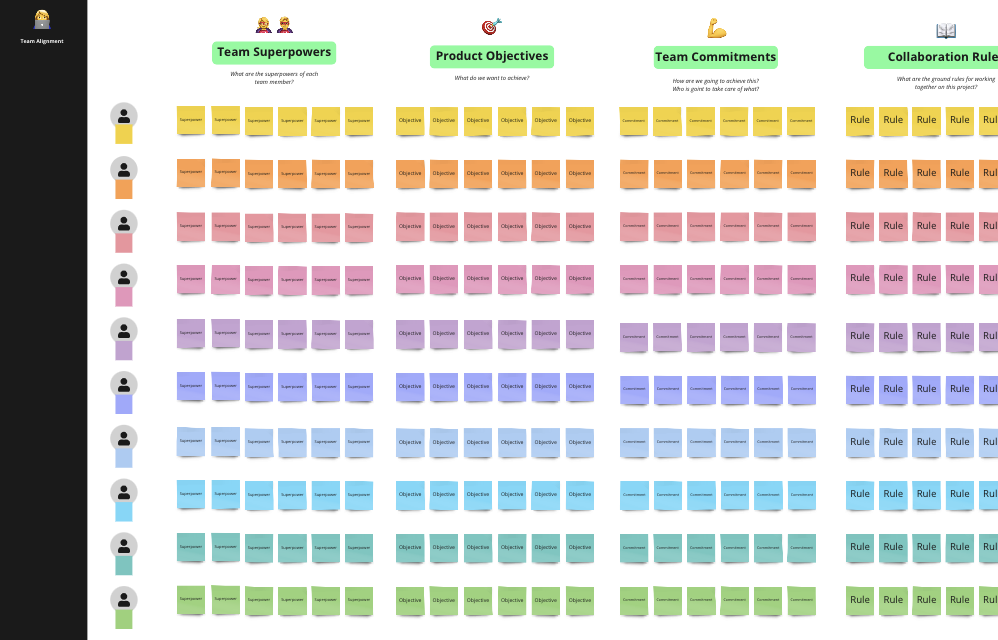
The objective of this meeting is to get everyone on board by aligning the team through a number of exercises:
- Team Superpowers: ask every team member to list their superpowers, meaning their strength and the things they are especially good at.
- Team Objectives: ask every team member to list what they consider to be the most important objectives for this project, meaning what you want to achieve as a team. Then discuss them in the group and agree on a selection of objectives for the whole team, that everyone should work towards.
- Team Commitments: now look at everyone’s superpowers as well as the work package and activities on the roadmap. Based on that discussed in the team who is going to do what and ask everyone to clearly write down what everyone will commit to in order to make sure to achieve the objectives you agreed on.
- Collaboration Rules: Finally, lay the ground rules for the collaboration. Ask everyone to list the rules they think the team should stick to, in order to assure good and efficient team work. Discuss the proposed rules in the team and decide on a common set of rules that everyone agrees to stick to.
Sprint Kick-off
At the start of each sprint, the execution team meets with the Product Owner to discuss the highest-priority items in the product backlog and selects the items to be completed during the sprint. Based on this the team adapts or creates the sprint to dos.
Use the Product Roadmap & KANBAN board to understand where you stand and what the tasks are for the coming sprint
Daily Stand-up
During the sprint, the development team meets daily for a quick stand-up meeting to review progress, identify any obstacles or issues, and plan their work for the next 24 hours. This meeting helps keep the team aligned and focused on completing the sprint backlog.
Use the Product Roadmap & KANBAN board to review the tasks’ progress and clarify what the team will work on today
Sprint Review & Retrospective
At the end of the sprint, the team delivers a potentially shippable product and holds a sprint review with the Product Owner and other stakeholders to review and provide feedback on the work completed during the sprint.
Use the Product Roadmap & KANBAN board to review which tasks were completed in the past sprint
After the review, the team holds a retrospective to reflect on the sprint and identify areas for improvement. The team discusses what went well, what didn’t go well, and what changes can be made to improve the next sprint.
You can use the Team Retrospective 📒Template that we prepared to recap on your sprint with the sailboat retrospective methods.
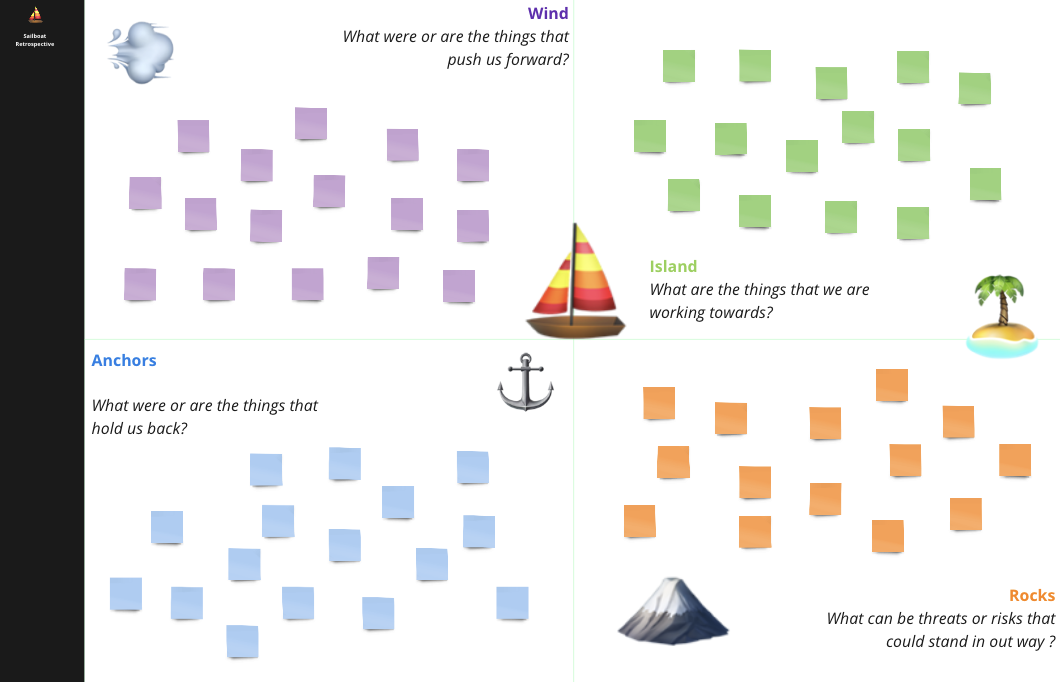
Ask the team members to use the post-its and note down their thoughts on:
- ⚓The Anchors: What were or are the things that held you back during your sprint?
- ⛰️The Rocks: What can be threats or risks that could stand in out way ?
- 🌬️The Wind: What were or are the things that pushed you forward?
- 🏝️ The Island: What are the things on the horizon that you are working towards?

